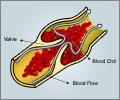Most cancer-related blood clots occur when a person is out of the hospital, at home or elsewhere while on chemotherapy, shows study.

"One in five patients develops blood clots after a cancer diagnosis and we believe that number is rising," Khorana said. "The Surgeon General recently issued a Call to Action to reduce VTE. At this point public health efforts have focused on inpatient prophylaxis. These new data suggest that to reduce the burden of VTE in cancer patients, prevention efforts will have to shift to the outpatient arena as well."The cost of care for patient with blood clots was twice as high compared to patients who did not have that complication, Khorana also reported.Khorana was invited to present his data at the 2011 ASH (American Society of Hematology) annual meeting in San Diego, attended by approximately 20,000 physicians and scientists.
The scientific abstracts with the highest impact, including Khorana's, were selected for platform talks. Khorana and his research team conducted a retrospective, observational study between 2005 and 2009 from healthcare claims databases, which they believe is the largest population study of this kind. The databases provided both inpatient and outpatient information. Of the 17, 784 cancer patients identified, 5.6 percent developed blood clots, the study said.
Of those who suffered from the complication, 21 percent had recently been hospitalized but 78.3 percent were being treated on an outpatient basis.The medical term venous thromboembolism is a mass of red blood cells, clotting proteins and platelets that block the normal flow of blood. Clots form most often in the legs, lungs, or abdomen, and are life-threatening if not treated. Cancer patients are more prone to blood clots for many reasons: the malignancy itself can secrete proteins associated with blood clots; several treatments (including surgery, chemotherapy, and hormonal therapy) raise the clot risk; decreased mobility due to active disease or hospitalization; a genetic predisposition; or having other health problems, such as infections, obesity, anemia, and lung disorders. And once a blood clot occurs, a cancer patient is much more likely to have other clots later."Ongoing public health issues that we must address are how to educate patients on the importance of blood clot prevention, and improving compliance to preventive treatment," he said. Patients should immediately report to their physicians any unusual symptoms such as swelling or redness in limbs, or shortness of breath, even if they are otherwise feeling well.
Source-Eurekalert














